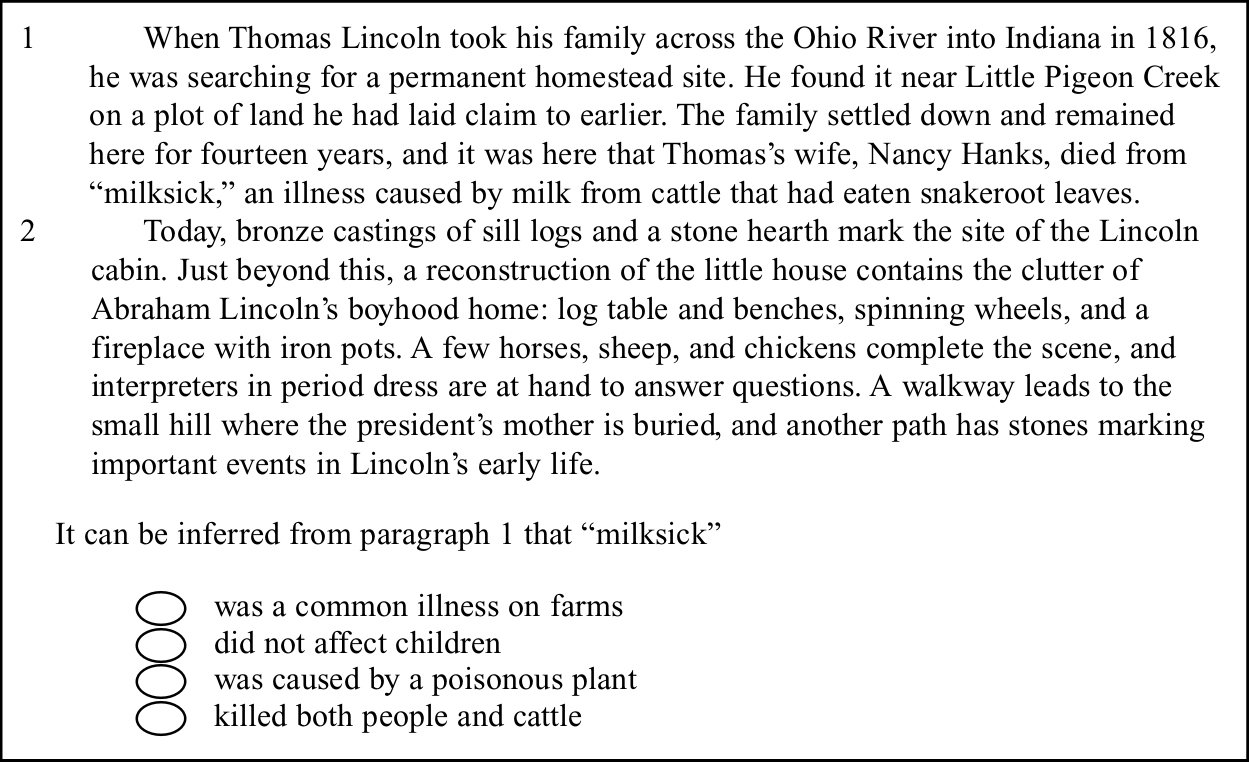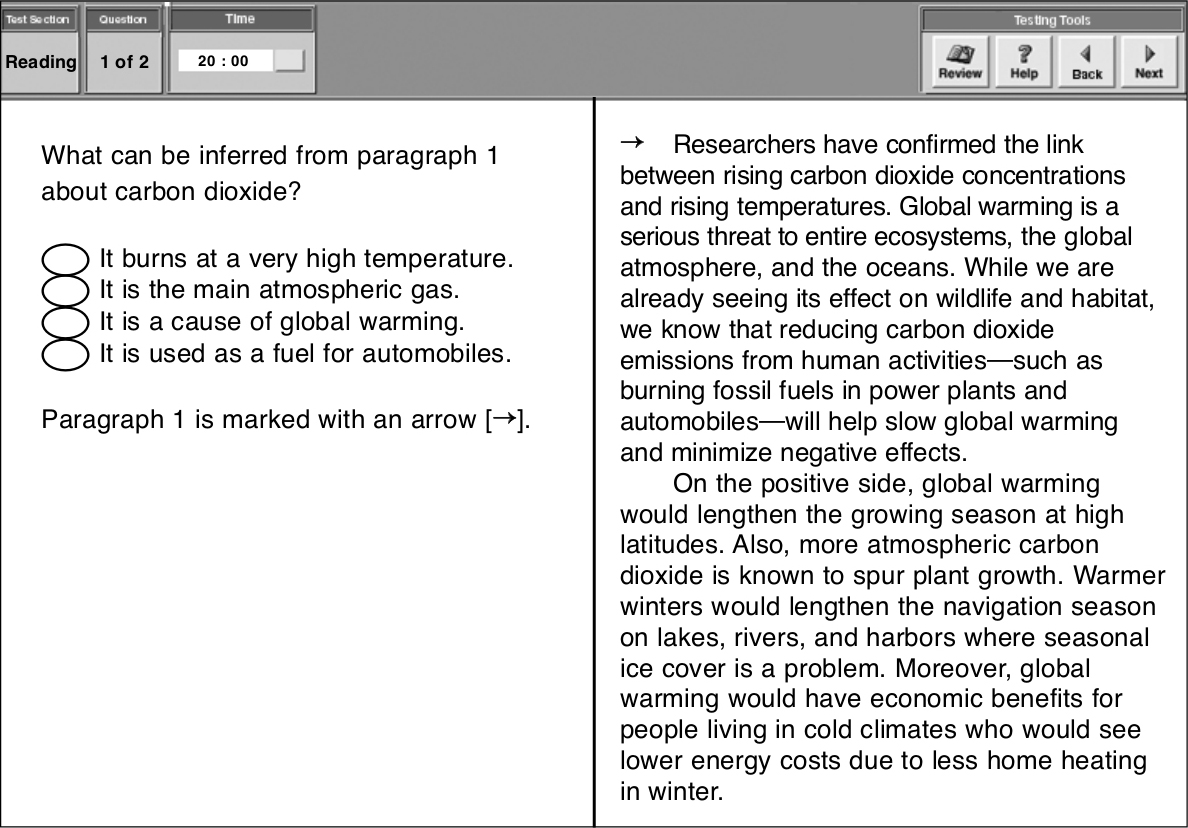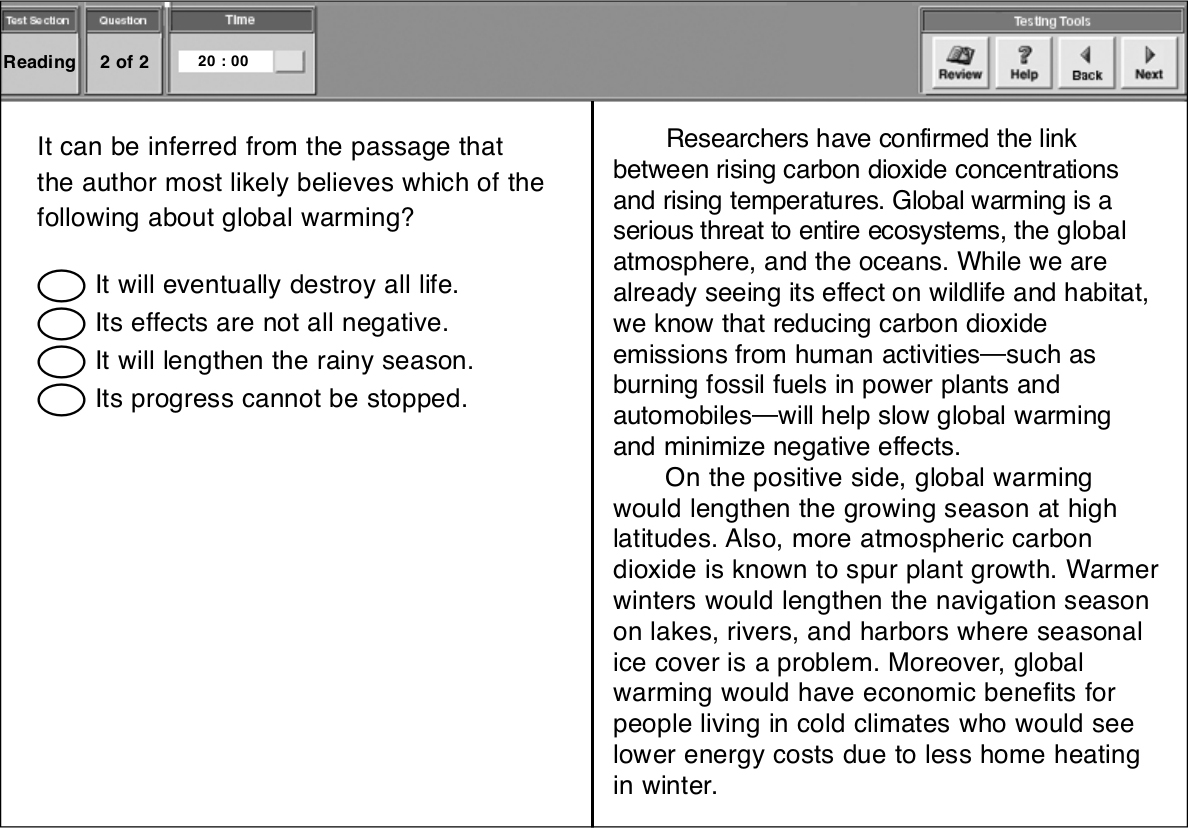




 1.4 Making Inferences
1.4 Making Inferences
 FOCUS
FOCUS
阅读下面的文章并回答问题:

根据这段文章,你对milksick了解多少?知道这种东西导致一个女人死亡,而它是由产自那些吃过蛇根草的牛的牛奶引起的。因此,可以推断出milksick是由一种有毒植物引起的(was caused by a poisonous plant)——这就是正确答案。其他选项无法从原文推断出来。
现在回答另一个问题:

考生可以推断出林肯故居现在是座博物馆(The site of the Lincoln homestead is now a museum)。线索如下:
Today…mark the site of the Lincoln cabin. …interpreters in period dress…
…a reconstruction of the little house… …stones marking important events…
其他选项无法从原文中合理推断出。
 STUDY
STUDY
1. Inferences
推断(inference)是考生根据文章中的信息可以得出的结论,是考生根据作者的陈述可以合理判断为正确的观点。有些推断可能来自一句话,而有些则需要以整段或者整篇文章为基础。
推断是“隐含(hidden)”的观点。作推断时,考生必须理解作者没有直接陈述的观点。为此,考生首先必须理解作者直接给出的信息。至于作者没有直接或公开给出的信息,他/她可能会在提到某些事实和细节的时候给出暗示。当作者在暗示什么的时候,考生一定要借助已给的信息推断或总结出暗示的内容。
进行推断时,除了推理、逻辑和常识以外,还要利用关键词和文中的各种观点以及考生对作者所要传达的信息的整体理解。
托福考试推断题形式如下:
What can be inferred about_____?
It can be inferred from paragraph __ that _____.
Which of the following can be inferred from paragraph __?
Which of the following statements is most likely true about _____?
What probably occurred after _____?
It can be inferred from the passage that the author most likely believes which of the following about _____?
Which of the following statements most accurately reflects the author’s opinion about_____?
Paragraph _____ supports which of the following statements about _____?
2.Answer Choices
在推断题中,选项错误的原因通常为:
 不被文中给出或暗示的信息所支持;
不被文中给出或暗示的信息所支持;
 过于笼统或过于模糊;
过于笼统或过于模糊;
 对于文章来说不准确或不真实;或
对于文章来说不准确或不真实;或
 与文章不相关或没被提及。
与文章不相关或没被提及。
3. Sample Questions

题目要求考生就二氧化碳(carbon dioxide)进行推断。正确答案是It is a cause of global warming。第一段中有一些线索:
…confirmed the link between rising carbon dioxide concentrations and rising temperatures…
…reducing carbon dioxide emissions…will help slow global warming….
其他选项无法根据原文信息推断出来。文中没有提到It burns at a very high temperature。It is the main atmospheric gas过于模糊,且不为文中信息所支持。It is used as a fuel for automobile表述不准确,因为二氧化碳是燃烧化石燃料的结果或产物——本身并不是燃料。

题目要求考生推断作者对于全球变暖有什么看法。考生必须根据作者的话作出推断。观察每一个选项,判断它们是否可以从原文中合理推断出来。文章中有没有单词或观点支持答案?
作者最有可能同意Its effects are not all negative,这也就是正确答案。相关线索有:
On the positive side, global warming would….
Warmer winters would lengthen the navigation season on lakes, rivers, and harbors….
Moreover, global warming would have economic benefits….
It will eventually destroy all life不为文中信息所支持。It will lengthen the rainy season 意思不准确;根据文章可知,全球变暖将会延长航海的季节(lengthen the navigation season),而不是雨季(rainy season)。Its progress cannot be stopped 意思也不准确;作者认为reducing carbon dioxide emissions from human activities...will help slow global warming and minimize negative effects。
 PRACTICE
PRACTICE
Read the passages and choose the best answer to each question.
QUESTION 1
In classical and medieval times, the study of music shared many features with the discipline of mathematics, such as an interest in proportions, special ratios, and recurring patterns. In the twentieth century, the introduction of twelve–tone music and the widespread use of computers inspired further study into the relationship between musical and mathematical abilities. Musical performances require sensitivity to ratios that are often complex, and to appreciate the operation of rhythms, a performer must have some basic numerical competence.
1. Which of the following can be inferred from the passage?
A The disciplines of music and mathematics originated in classical times.
B People have long been aware of links between music and mathematics.
C Both music and mathematics require an understanding of computers.
D Professional musicians must study mathematics at the university level.
QUESTION 2
Corvids are sociable and tend to form social groups. This is particularly true of rooks,which stay in their flocks all year round. The raven, largest of the corvids, joins a social group as a juvenile, pairing off at around the age of three and mating for life. Courtship can involve such games as pair snow sliding and the synchronized flight test. Corvids can be found all over the world. The adaptability and intelligence of this family have made them extremely successful. For centuries, the raven and the crow have held a special place in the mythology of various cultures.
2. It can be inferred from the passage that corvids are
A a family of birds
B games for children
C members of a sports club
D imaginary beings
QUESTION 3
The input of solar energy supplies 99 percent of the energy needed to heat the earth and all buildings on it. How is this possible? Most people think of solar energy in terms of direct heat from the sun. However, broadly defined, solar energy includes direct energy from the sun as well as a number of indirect forms of energy produced by this direct input.Major indirect forms of solar energy include wind, hydropower, and biomass—solar energy converted to chemical energy in trees, plants, and other organic matter.
3. It can be inferred from the passage that the author most likely believes which of the following about solar energy?
A Solar energy is not used as much as it could be used.
B It is not possible to develop direct forms of solar energy.
C Trees, plants, and organic matter can store solar energy.
D The definition of solar energy will continue to change.
QUESTION 4
The reasons for the migration from rural to urban life were exploitation and lack of economic opportunity. The family members who would not inherit a share in the property were exploited by the laws of inheritance. The system was particularly hard on women, who usually did not share in the ownership of the farm and who rarely were paid for their labor. The workday for women was even more demanding than it was for men. Women were responsible for the kitchen garden and the small livestock as well as the care of the family. Unmarried women increasingly left the farm in search of economic opportunity in the factories that processed fish or farm products.
4. It can be inferred from the passage that women under this system
A moved from farm to farm in search of work
B were paid less than men for the same work
C did not acquire property through inheritance
D had to get married in order to stay on the farm
QUESTIONS 5–6
One of the most significant elements of age stratification in all cultures is the pattern of experiences connected to marriage and parenting—a pattern that sociologists call the family life cycle. In North America, about 90 percent of adults marry, and the great majority of them have children and thus a family life cycle related to family experiences. When the family’s first child is born, the parents embark on a sequence of experiences linked to the child’s development—from infancy and toddlerhood, through school age and adolescence,and eventually, to departure from the nest. Each of these periods in the child’s life makes a different set of demands on the parents.
5. The phrase embark on in the passage is closest in meaning to
A attempt
B begin
C discuss
D avoid
6. It can be inferred from the passage that the family life cycle
A takes place whether or not people have children
B does not occur in cultures outside of North America
C must be redefined from one generation to the next
D shapes several years in the lives of most adults
QUESTIONS 7–8
1 Some people believe that odors and fragrances affect the body and mind and are capable of healing anxiety, stress, and other sources of disease. Interest in aromatherapy—and the use of aromatherapy products such as lotions and inhalants—continues to boom. Some popular essential oils and their uses in aromatherapy include lavender and chamomile,which are reputed to ease stress and promote sleep. The scent of jasmine will uplift the mood and reduce depression. Orange eases anxiety and depression and promotes creativity. Peppermint has antibacterial and analgesic qualities, eases mental fatigue, and relieves headaches.
2 However, aromatherapy is not for everyone. For people who suffer from fragrance sensitivity, asthma, or allergies, aromas like perfumes can prompt disabling health problems,including headaches, dizziness, nausea and vomiting, fatigue, difficulty breathing, difficulty concentrating, flu–like symptoms, and anaphylaxis.
7. It can be inferred that aromatherapy is
A the main use of essential oils from plants
B the use of certain scents to promote health
C not recommended for treating headaches
D not an effective method of curing disease
8. All of the following fragrances are believed to reduce stress EXCEPT
A lavender
B jasmine
C chamomile
D orange
QUESTIONS 9–10
1 Animal behaviorists believe the orangutan is a cultured ape, able to learn new living habits and to pass them along to the next generation. Some orangutan parents teach their young to use leaves as napkins, while others demonstrate the technique of getting water from a hole by dipping a branch in and then licking the leaves. Orangutans have been observed saying goodnight with the gift of a juicy raspberry. Such social interactions lead researchers to conclude that if orangutans have culture, then the capacity to learn culture is very ancient.
2 In the evolutionary timeline, orangutans separated from the ancestors of humans many millions of years ago, and they may have had culture before they separated. The discovery of orangutan culture suggests that early primates—including ancestors of humans—might have developed the ability to invent new behaviors, such as tool use, as early as 14 million years ago, approximately 6 million years earlier than once believed.
9. What can be inferred from paragraph 1 about social interactions related to teaching and learning?
A They are behaviors that only orangutans have displayed.
B They are misunderstood by animal behaviorists.
C They indicate similarities between orangutans and other apes.
D They provide evidence that orangutans have culture.
10. Which of the following can be inferred from paragraph 2?
A The ancestors of humans learned culture from orangutans.
B Orangutans were more advanced than most other early primates.
C Primate culture may be older than scientists used to believe.
D Scientists have found orangutan tools that are 6 million years old.
Read the passages and choose the best answer to each question.
QUESTIONS 1–2
1 In the early nineteenth century, most of the Europeans who immigrated to the United States were from northern and western European countries such as England, Germany, France, and Sweden. However, most of the fifteen million Europeans arriving between 1890 and 1914 came from southern and eastern Europe, with the largest numbers coming from Russia, Italy, Greece, Austria–Hungary, and Armenia.
2 A similar pattern occurred in Canada, where most immigrants were traditionally from England and the United States. After 1890, an increasing number came from eastern Europe,particularly Russia and Ukraine. Many of these headed for the Prairie Provinces. The Doukhobors, a pacifist sect from southern Russia, established communal settlements in Saskatchewan. Together with other immigrants, they arrived in such numbers that in the two decades between the completion of the main railroad network and the outbreak of war in 1914, the population of the prairies had increased from about 150,000 to 1.5 million.
1. Which of the following can be inferred from paragraph 1 about European immigration to the United States in the nineteenth century?
A The sources of immigrants shifted to different parts of Europe.
B Most of the European immigrants could not speak English.
C More immigrants came from Europe than from other continents.
D Northern and western Europeans did not immigrate after 1890.
2. It can be inferred from paragraph 2 that the Doukhobors
A were the largest immigrant group in North America
B also immigrated to the United States
C mainly settled in the Canadian prairies
D helped to build Canada’s railroad network
QUESTIONS 3–6
1 David Smith worked primarily in iron, exploring its possibilities more fully than any other sculptor before or since. To Smith, iron spoke of the power, mobility, and vigor of the industrial age. Smith was born in Indiana in 1906, the descendant of a nineteenth–century blacksmith. His iron sculptures flowed naturally out of the mechanized heart of America, a landscape of railroads and factories. As a child, Smith played on trains and around factories, as well as in nature on hills and near creeks. He originally wanted to be a painter, but after seeing photographs of the metal sculpture of Picasso in an art magazine,he began to realize that iron could be handled as directly as paint.
2 Many of Smith’s sculptures are “totems” that suggest variations on the human figure. They are not large iron dolls, although several have “heads” or “legs.” Still, they forcefully convey posture and gesture. Their message flows from the internal relations of the forms and from the impression of tension, spring, and alertness set up by their position in space.
3 Later in his career, Smith produced two series of sculptures in stainless steel: the Sentinels in the 1950s and the Cubis in the 1960s. He also began placing his sculptures outdoors, in natural light, where the highly reflective stainless steel could bring sunlight and color into the work. In the late afternoon sun, the steel planes of the Cubis reflect a golden color; at other times, they have a blue cast. The mirror–like steel creates an illusion of depth, which responds better to sunshine than it would to the static lighting of a museum.
3. The word vigor in paragraph 1 is closest in meaning to
A history
B poverty
C lifestyle
D strength
4. Which of the following can be inferred from paragraph 1 about David Smith’s background?
A He gained experience while working in a blacksmith factory.
B His childhood exposed him to the uses and possibilities of iron.
C His early sculptures revealed his desire to be a landscape painter.
D He first learned about metals by seeing pictures in a magazine.
5. What can be inferred about the Sentinels and the Cubis?
A They are the best–known examples of Smith’s “totem” sculptures.
B Smith originally intended to use iron instead of stainless steel.
C The Sentinels are made of blue steel, and the Cubis are of gold steel.
D They each consist of a number of pieces placed in outdoor settings.
6. It can be inferred from the passage that the author most likely believes which of the following about David Smith’s works?
A His metal sculptures are more interesting than are those of Picasso.
B His sculptures attempt to portray the proportions of the human body.
C His pieces capture the power of industry and the beauty of natural light.
D His works are best appreciated when viewed all at once in a museum.
QUESTIONS 7–10
1 Long ago, people looked up in the sky and noticed groups of stars that looked like pictures. These patterns of stars, constellations, have been part of human culture for thousands of years. Ancient Syrians and Babylonians named many constellations and created stories about them. The Greeks and Romans later adopted these constellations and translated their names and stories into their own language. After the decline of these ancient cultures, most knowledge of constellations remained hidden in private libraries. Beginning in the eighth century, scholars rediscovered this knowledge. The study of astronomy spread quickly throughout the Mediterranean world, becoming part of university study. Astronomers identified many constellations only a few centuries ago. When Western astronomers started traveling to South Africa in the seventeenth century, they found numerous brilliant stars in the Southern sky. They named some of these Southern constellations after the scientific inventions of the time, such as the Microscope and the Air Pump.
2 Today’s astronomers view constellations simply as areas of the sky where interesting objects await observation and study. The entire sky is divided into 88 such regions. In the 1920s, the International Astronomical Union established the boundaries of these regions. In each region, astronomers give Greek letters to a constellation’s brighter stars, usually in order of brightness. Hence, the “alpha star” is the brightest star of that constellation. Scientists and ordinary people still refer to many constellations by their popular names, for example, the Lion, the Hunter, and the Great Bear.
7. Which of the following can be inferred from paragraph 1?
A Constellations have interested people for a very long time.
B People once believed incorrect stories about constellations.
C Ancient cultures disagreed about the shapes of constellations.
D Most knowledge of constellations has been lost forever.
8. It can be inferred from paragraph 1 that the ancient Greeks and Romans
A were the first people to notice patterns of stars in the sky
B built universities all over the Mediterranean region
C hid knowledge of constellations in private libraries
D acquired knowledge of constellations from earlier cultures
9. It can be inferred from paragraph 2 that
A there are no constellations in some areas of the sky
B scientists today continue to study constellations
C the boundaries of the constellations change every year
D the International Astronomical Union no longer exists
10. According to paragraph 2, which of the following statements is most likely true?
A Future scientists will divide the sky into fewer regions.
B There are no more constellations for scientists to discover.
C A constellation’s alpha star is the one that is easiest to see.
D Few people know the traditional names of constellations.
Read the passages and choose the best answer to each question.
QUESTIONS 1–4
1 The human ear contains the organ for hearing and the organ for balance. Both organs involve fluid–filled channels containing hair cells that produce electrochemical impulses when the hairs are stimulated by moving fluid.
2 The ear can be divided into three regions: outer, middle, and inner. The outer ear collects sound waves and directs them to the eardrum separating the outer ear from the middle ear. The middle ear conducts sound vibrations through three small bones to the inner ear. The inner ear is a network of channels containing fluid that moves in response to sound or movement.
3 To perform the function of hearing, the ear converts the energy of pressure waves moving through the air into nerve impulses that the brain perceives as sound. Vibrating objects, such as the vocal cords of a speaking person, create waves in the surrounding air.These waves cause the eardrum to vibrate with the same frequency. The three bones of the middle ear amplify and transmit the vibrations to the oval window, a membrane on the surface of the cochlea, the organ of hearing. Vibrations of the oval window produce pressure waves in the fluid inside the cochlea. Hair cells in the cochlea convert the energy of the vibrating fluid into impulses that travel along the auditory nerve to the brain.
4 The organ for balance is also located in the inner ear. Sensations related to body position are generated much like sensations of sound. Hair cells in the inner ear respond to changes in head position with respect to gravity and movement. Gravity is always pulling down on the hairs, sending a constant series of impulses to the brain. When the position of the head changes—as when the head bends forward—the force on the hair cells changes its output of nerve impulses. The brain then interprets these changes to determine the head’s new position.
1. What can be inferred about the organs for hearing and balance?
A Both organs evolved in humans at the same time.
B Both organs send nerve impulses to the brain.
C Both organs contain the same amount of fluid.
D Both organs are located in the ear’s middle region.
2. Hearing involves all of the following EXCEPT
A motion of the vocal cords so that they vibrate
B stimulation of hair cells in fluid–filled channels
C amplification of sound vibrations
D conversion of wave energy into nerve impulses
3. It can be inferred from paragraphs 2 and 3 that the cochlea is a part of
A the outer ear
B the eardrum
C the middle ear
D the inner ear
4. What can be inferred from paragraph 4 about gravity?
A Gravity has an essential role in the sense of balance.
B The ear converts gravity into sound waves in the air.
C Gravity is a force that originates in the human ear.
D The organ for hearing is not subject to gravity.
QUESTIONS 5–10
1 The Pacific Northwest coast of North America is a temperate rain forest, where trees like the red cedar grow straight trunks more than two meters thick at the base and sixty meters high. Western red cedar is often called the canoe cedar because it supplied the native people of the region with the raw material for their seagoing dugout canoes. These extraordinary crafts, as large as twenty meters in length, were fashioned from a single tree trunk and carried as many as forty people on fishing and whaling expeditions into the open ocean.
2 The Haida people from the Queen Charlotte Islands off British Columbia were noted for their skill in canoe building. After felling a giant tree with controlled burning, the canoe makers split the log into lengthwise sections with stone wedges. They burned away some of the heartwood, leaving a rough but strong cedar shell. They then carved away wood from the inside, keeping the sections below the waterline thickest and heaviest to help keep the canoe upright in stormy seas. To further enhance the canoe’s stability, they filled the hull with water and heated it to boiling by dropping in hot stones. This rendered the wood temporarily flexible, so the sides of the hull could be forced apart and held with sturdy wooden thwarts, which served as both cross braces and seats. The canoes were often painted with elaborate designs of cultural significance to the tribe.
3 The Haida raised canoe building to a high art, designing boats of such beauty and utility that neighboring tribes were willing to exchange quantities of hides, meats, and oils for a Haida canoe. These graceful vessels became the tribe’s chief item of export. In their swift and staunch canoes, the first people of the Northwest were able to take full advantage of the riches provided by the sea. With harpoons of yew wood, baited hooks of red cedar,and lines of twisted and braided bark fibers, they fished for cod, sturgeon, and halibut,and hunted whales, seals, and sea otters.
5. The word fashioned in paragraph 1 is closest in meaning to
A thrown
B lowered
C made
D decorated
6. Why did the canoe makers keep the sections of the canoe below the waterline thickest and heaviest?
A To prevent the canoe from overturning in rough water
B To shorten the work of carving wood from the inside
C To avoid having to paint the bottom of the canoe
D To make the canoe strong enough to hold forty people
7. Which of the following can be inferred from paragraph 2?
A Carving changed the texture and strength of the wood.
B It took the canoe makers several months to build a canoe.
C The wood was beaten with stone tools to make it flexible.
D Canoes were important cultural artifacts of the Haida.
8. The word staunch in paragraph 3 is closest in meaning to
A silent
B strong
C scented
D severe
9. It can be inferred from paragraph 3 that
A canoes were the Haida’s only known art form
B the Haida dominated trade among local tribes
C the people used up all of the natural resources
D trees provided essential tools for obtaining food
10. Which of the following statements can be inferred from the passage?
A The western red cedar thrives in a variety of climates.
B The skill of the Haida canoe makers has never been copied.
C Haida canoes were of great value in the regional economy.
D People no longer use cedar canoes for fishing and whaling.
Answers to Exercises 1.4.A through 1.4.C are on pages 639–640.
 EXTENSION
EXTENSION
1. 三四个人为一组,阅读下面的文章,写出一些可以通过文中信息推断出的结论。10分钟后,把你们的推断向全班公布,并找出支持你们组每个结论的文章信息。
A distinction between two kinds of intelligence—crystallized and fluid intelligence—has been widely studied by researchers studying adult learning. Crystallized intelligence is heavily dependent on education and experience. It consists of the set of skills and knowledge that we each learn as part of growing up in any culture. It includes such skills as vocabulary, the ability to reason clearly about real–life problems, and the technical skills we learn for our jobs. Crystallized abilities are “exercised” abilities.
Fluid intelligence, in contrast, is thought to be a more “basic” set of abilities, not so dependent on specific education. These are the “unexercised” abilities. Most tests of memory tap fluid intelligence.
Crystallized abilities generally continue to rise over our lifetime, while fluid abilities begin to decline much earlier, beginning perhaps at age 35 or 40.
2. 和你的老师、同学一起讨论事实和推断之间的区别。当你认识的某个人说了一句话,你怎么分辨那是事实还是推断?事实和推断是否总是一致呢?
3. 从新闻、杂志或大学课本中选出一篇文章。在课上,三四个人为一组阅读文章,先将文章中的事实信息罗列出来,然后写出一些可以根据文中信息作出的推断或结论。把文章、事实信息和你们的推断都贴在教室里可以看见的地方。